



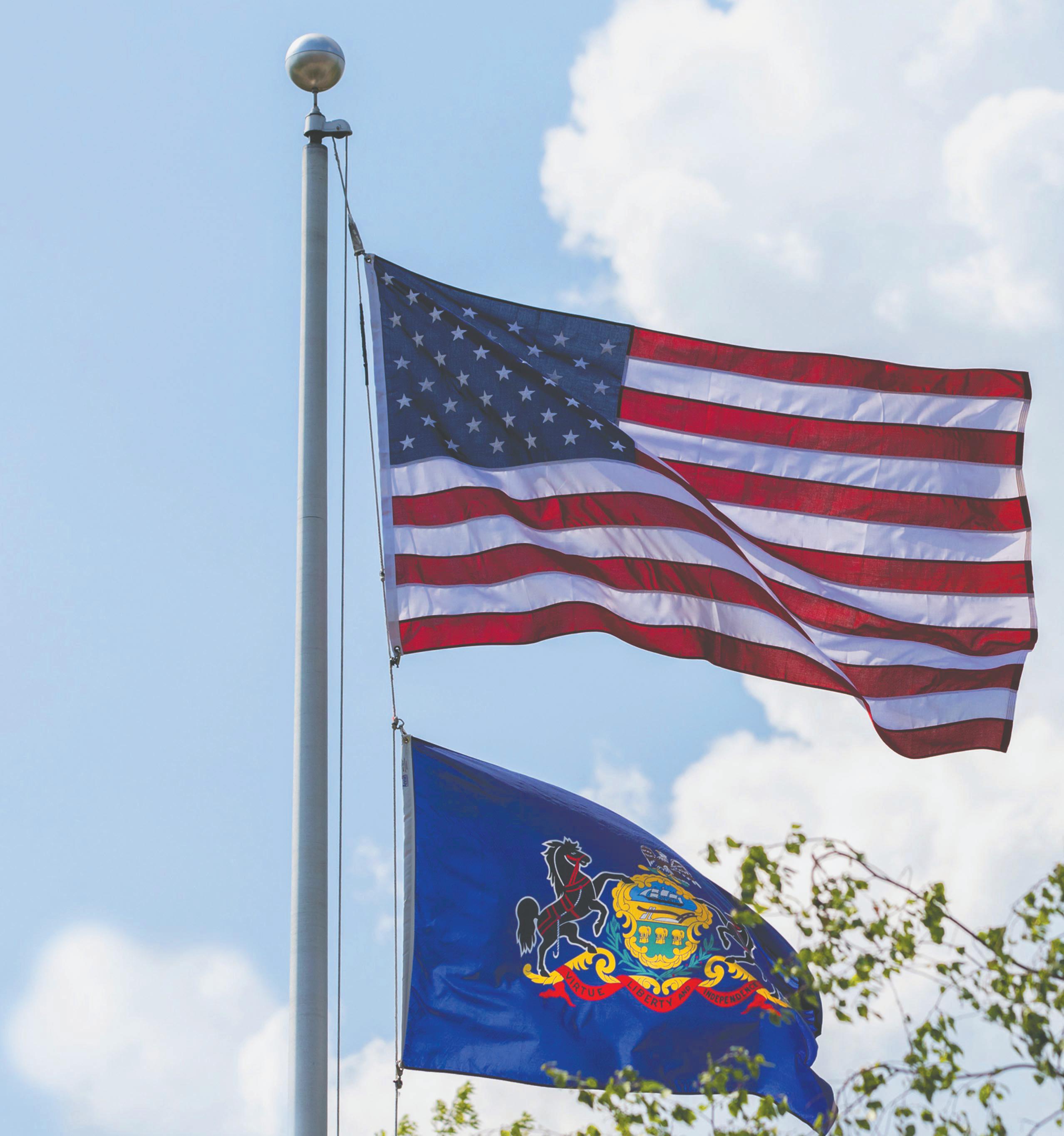
On Veterans Day — and every day — we sincerely thank those who served and continue to serve so bravely, including members of our campus community.






On Veterans Day — and every day — we sincerely thank those who served and continue to serve so bravely, including members of our campus community.
By Marcie Schellhammer
ELDRED — About 82 years ago, Dick Bondi decided to take a walk. It probably wasn’t the best idea, he said.
“It was pretty dumb,” he told a reporter September 2 at the Eldred World War II Museum, with a laugh and a big smile. It was wartime, he was serving in the Philippines and thought he’d walk to Manila.
Americans weren’t greeted with hugs and how-do-you-dos, but with gunfire.
He’ll be 100 next month so, obviously, he made it.
A native of Geneseo, N.Y., he now lives in Dansville, N.Y., with family. He served in the U.S. Navy in submarine service in World War II and again in the Korean War.
He’s a familiar face at the Eldred museum; he and a fellow submarine veteran rededicated the submarine display a few years back, and his grandsons did an Eagle Scout project on it.
Bondi and fellow World War II veteran Bernard Adams, 102, formerly of Shinglehouse, were honored at the museum Tuesday in a Victory in Japan Day ceremony. Two fellow veterans — state Sen. Cris Dush, R-Brookville, Air Force, and state Sen. Doug Mastriano, R-Chambersburg, retired U.S. Army colonel and chairman of the Senate Veterans Affairs and Emergency
Preparedness Committee — along with Steve Appleby, Army retired and curator emeritus of the museum, spoke of the history of the war with Japan and of V-J Day.
“Eighty years ago today World War II ended. That famous picture of the soldier and the nurse kissing (on the cover of LIFE Magazine) happened 80 years ago today,” Mastriano said Tuesday. He played a video of the signing of Japan’s surrender in Tokyo Bay.
“This will be the last large commemoration when veterans of World War II are with us,” he said. “On this day the guns finally fell silent across the world. It was the most devastating war in human history and it came to an end 80 years ago. A generation had carried the weight of freedom and had returned home scarred but victorious,” he continued. “That victory came at a great cost. Over 400,000 Americans never came home.”
Many more were injured physically and otherwise.
“They believed the cause of liberty was greater than their own lives,” he said.
Mastriano spoke of Olean, N.Y., native Louis Zamperini, and his story that is told in the book and film “Unbroken.” Mastriano’s family hosted Zamperini in their house in Germany when he spoke to American soldiers there. Zamperini had been an athlete in the

1936 Olympics in Berlin, and had shaken Hitler’s hand, the senator said. He later served in the Army Air Forces, was shot down, washed up on the Marshall Islands after 47 days adrift and was captured by the Japanese. And was tortured.
Mastriano said Zamperini suffered from post-traumatic stress disorder until he attended a Billy Graham Crusade and accepted Jesus into his life. He then met several of his captors and forgave them.
“Another good friend of the family was Robert ‘Bob’ Boardman,” Mastriano said. He told a similar story of hardships suffered at wartime, and that accepting Jesus into his life changed him for the better.
“These were giants
in our time. These incredible men and women were just so humble,” he said. He urged families to share their veterans’ stories so the next generations will remember.
“Victory is not just winning battles or forcing surrender. True victory is when courage overcomes fear. When honor outlasts hardship. When forgiveness triumphs over hate,” Mastriano said.
“We honor them by living lives worthy of the price they paid,” he said. “When we face division, let us remember Americans once stormed beaches side by side regardless of their politics, never asking their comrade where they came from or what political views they had.”
He introduced Dush, who said, “About 1% of
our nation’s population are veterans. But here in the northern tier of Pennsylvania, if you go by any cemetery, like the one just down the street here,” he said, pointing toward Lamphier Cemetery, “those flags are everywhere” marking veteran graves.
In our area, I’m very proud of the representation and the number of people who step up and have stepped up,” Dush said. “Generations of people from the very beginning, from the Bucktail Regiment. We’ve got a long history of dedication to the covenant we protect.
“We fought to have freedom,” he said.
Speaking of the museum, Dush said, “This is another reflection of how deeply we care.”
Addressing the war with Japan, the senator spoke about Pearl
Harbor and the men on submarines, like Bondi, whose lives were lost, and their bodies were never recovered.
He, too, referred to the kiss on the cover of LIFE Magazine.
“That kiss was a closure,” he said. That was when America could breathe a sigh of relief that the war was over.
Turning to the crowd, Dush said, “I will recognize Mr. Adams over here. He’s a bit of a flirt at over 100 years old. He’s still got it.”
Adams enlisted after Pearl Harbor, and volunteered to man guns on ships escorting merchant vessels across the Atlantic with critical supplies for the war effort — like oil. He was at Normandy, unloading supplies.
Dush then urged people to remember the service of veterans.
“That’s why days like this are important.”
Appleby spoke, and at the urging of Mastriano, shared the story of Mitchell Paige, whose military artifacts hold places of honor within the museum. Paige received the Medal of Honor for valor in combat for the ground battle for Guadalcanal, holding off the Japanese from taking over Henderson Field.
Also at the ceremony, the Smethport American Legion Post 138 performed the Posting of the Colors and the Otto-Eldred High School choir sang the national anthem and “God Bless America.”

By Kellen M. Quigley
ALLEGANY — In honor of the servicemembers who gave the ultimate sacrifice and the families who carry on their loved ones’ legacies, the Enchanted Mountain Garden Club of Allegany has made sure they are remembered for generations to come.
A Gold Star families memorial marker was unveiled Sept. 27 in a dedication ceremony attended by garden club members, local Gold Star families and local, state and military officials at the Allegany Town Hall park.
Emcee Gerri Lyter, Vice President of EMGC, said it was an honor to make the marker dedication a reality — to highlight and commemorate the sacrifices of the local Gold Star families and their servicemembers. The club purchased the marker, which is now part of the Allegany Veterans Memorial.
The project was spearheaded by EMGC member Marti Tillinger, who suggested it to the club about two years ago. She met with Curt Crandall many times for many hours over 18 months to discuss various options with input from the American Legion and Auxiliary.
“Curt not only provided considerable time from his already busy schedule, but





he also donated the base for the plaque and attached it and installed both together this past Wednesday,” Lyter said. “It has been Marti’s privilege — our privilege — to work with Curt Crandall, on behalf of the garden club, to honor our Gold Star families with this plaque.”
Candace Clemens, Gold Star mother of Staff Sgt. Shawn Clemens, who died in service in 2004, said the Gold Star families honored Saturday are tough, determined, loving and giving. She said they strive to make a difference in the lives of others and honor their lost loved ones.
“These families have worked hard to over-




come terrible tragedies in their lives,” she said.
“Thank you for making a difference in my family’s life and theirs with this wonderful Gold Star family recognition. This plaque will forever remember the sacrifice these families and their loved ones have given to our country.”
Master Sgt. Francisco Morales (Ret.), Director of Military Aligned Students Program at St. Bonaventure University, said Saturday’s ceremony was especially personal because he had the honor of serving with Shawn Clemens and was there the day he gave his life.
Morales said that day will stay with him for-
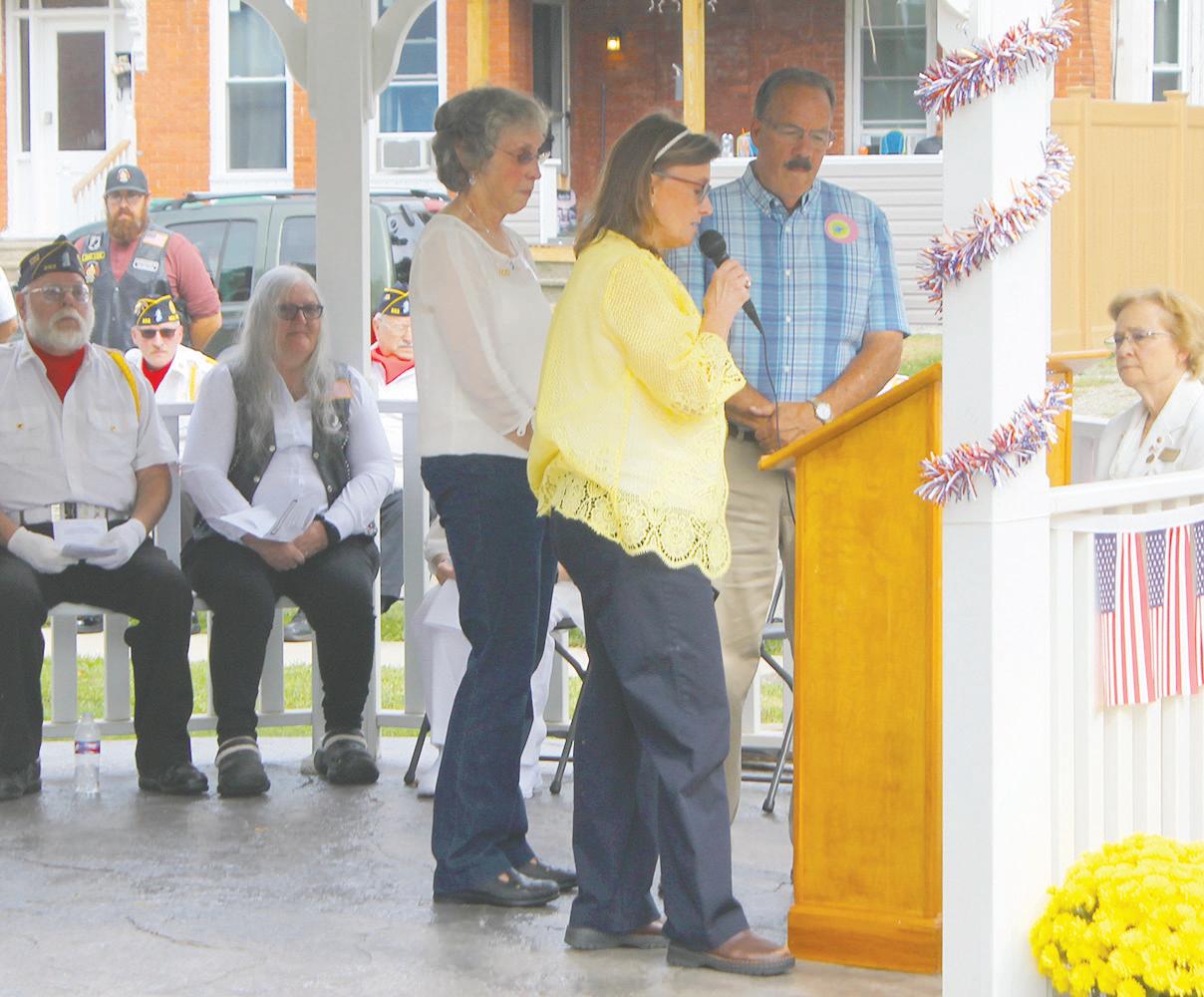






ever and has shaped the way he carries himself as a veteran, as a father and as a servant to the community.
“Candy, you’ve shown incredible strength, not only as a Gold Star mother but as a constant supporter of veterans,” he said. “Throughout your sponsorship of our veterans’ services at St. Bonaventure, you make sure we have a place of belonging to grow and to heal. You turn loss into love, and that love lifts us all up.”
Chris McPherson, Allegany Town Supervisor, said it’s important to remember that Saturday’s ceremony is not only the dedication of a marker but a way to honor a promise that those who gave their lives for their country will not be forgotten — and that their families will never stand alone.
“I hope this plaque will stand as a tribute: for honor, for hope and for healing. A place where all generations may reflect on the true cost of freedom,” he said.
Assemblyman Joe Sempolinski said he’s proud that the community he represents in Albany is so dedicated to the families of servicemembers, acknowledging their sacrifices and pain that is shared with the family member who gave the ultimate sacrifice. He said seeing Allegany step up and







































































honor those families with the marker is a wonderful act of community.
“To our fallen heroes, who I do believe can hear us, we’re going to take care of your families,” he added.
“This is our community’s way of saying they are not forgotten, that you’re not forgotten and you’ll always be remembered and honored in Allegany, Cattaraugus County and the state of New York.”
Other speakers during the ceremony included John Gordnier, Veterans Benefits Advisor with NYS Department of Veterans’ Services; Dorothy Reid, president of NYS Gold Star Families; and George Filgrove, representing state Senator George Borrello.
Following the speakers, Clemens unveiled the plaque at the
memorial as the Gold Star families looked on. Garden club member
Carol Shaffer placed a memorial wreath at the marker.
“As we gather today, we dedicate this Gold Star Families Memorial Marker to honor all our Armed Forces of America families, whose loved ones made the ultimate sacrifice defend-
ing the United States of America,” Lyter said. “It is with pride and appreciation that National Garden Clubs joins with the Gold Star families, the Enchanted Mountain Garden Club of Allegany, the town and village of Allegany and the state of New York to perpetuate this program with this marker that stands as a symbol for all Gold Star families.”
The American Legion Honor Guard was in attendance for the presentation of the colors and salute of the dead. Bob Fairbanks and Bill Fancher played Taps. Ray McKinney, Honor Guard chaplain, gave the invocation. Debbie Freeman with the American Legion Auxiliary gave the benediction.
Patriotic songs “The Star-Spangled Banner” and “God Bless America” were performed by the Allegany Alumni & Friends Band, with Alex Scalise providing vocals on the latter.
A reception was held at the Allegany American Legion following the ceremony.


By Savannah Barr
Honoring veterans is a cause close to Kierstin Taylor’s heart. The Bradford Area High School senior recently donated more than $900 to McKean County’s chapter of Wreaths Across America in honor of her late uncle, Sgt. 1st Class Andrew Taylor.
Taylor passed away when Kierstin was just 6 years old from complications related to diabetes while on active duty with the U.S. Army. He was 32 years old. During his 13 years of service, he completed four combat tours in Iraq and Afghanistan, serving both as a platoon sergeant and battalion operations sergeant. His dedication earned him numerous medals and achievement awards.
“As I prepare for my next chapter in life, I am realizing how much he and other service members have sacrificed, allowing me the opportunities I have as a U.S. citizen,” said Kierstin.
Wreaths Across America is a nonprofit organization dedicated to placing wreaths on veterans’ graves each December to honor and remember the sacrifices of our nation’s fallen heroes. When Kierstin learned about the program, she knew this would be a perfect way to pay tribute to her uncle and all those who made the ultimate sacrifice for our freedoms.
“I thought this was a wonderful way to remember these brave men and women over



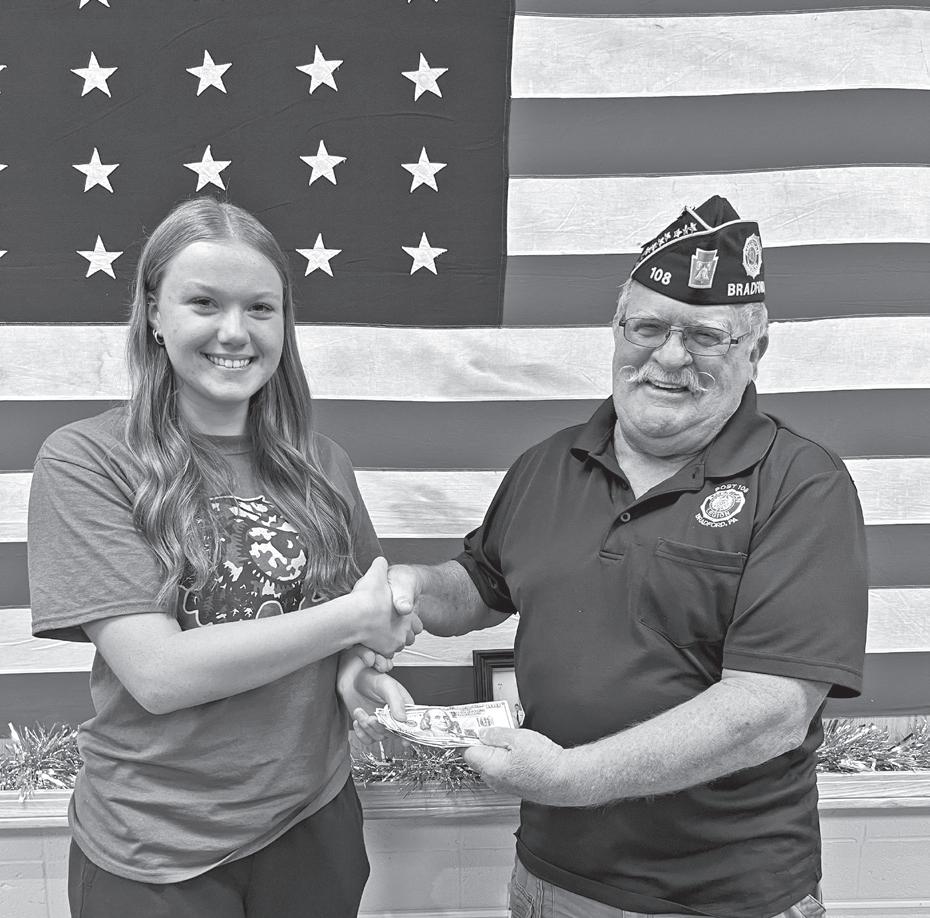
the upcoming holiday season,” said Kierstin.
The idea for the fundraiser grew from a military appreciation soccer game held in September, which Kierstin helped organize with her mother. As part of the event, her mother designed a t-shirt featuring a camouflage owl logo.
“I saw how much people loved the design and thought it was a great opportunity to raise funds for Wreaths Across America and honor my uncle,” Kierstin said.
The community’s response was overwhelmingly positive, and the Taylor family is touched by the support.
“My cousin, Annabele Taylor, who is the same age as me, is my Uncle Andrew’s daughter,” said Kierstin. “She and I are so honored when we see so many wearing the camo owl design, knowing this represents how respected and appreciated my uncle was.”
This holiday season will hold extra meaning for the family, as they plan to volunteer to-
gether to place wreaths on veterans’ graves.
“I am really excited and proud to see the wreaths go up this year, and my family and I are going to help put them out,” she said. “If anyone else would like to help, the American Legion Post 108 will need volunteers.”
Kierstin hopes that the success of her fundraiser will inspire other young people to support causes they care about and take time to remember those who have served. She hopes to see more schools use the idea of their logo in camouflage on t-shirts as a fundraiser for Wreaths Across America as well.
“It is important to remember those who have fought for our country and to keep their memory alive,” said Kierstin. Volunteers will place the wreaths on the second or third Saturday in December. Those who would like to help can call the Legion at (814) 368-8251, Bob Witchen at (814) 5984183 or Larry Fox at (814) 596-0043.






















CUBA — Sen.
George Borrello joined retired U.S. Army Brigadier General Arthur G. Austin Jr., along with his family, friends, fellow veterans and area leaders to honor him in August as the 57th Senate District’s 2025 inductee into the New York State Senate Veterans’ Hall of Fame.
The program celebrated a life of service that began nearly five decades ago and has continued well beyond Austin’s military retirement. The ceremony concluded with a luncheon at Moonwinks Restaurant and Lounge highlighting cuisines from the regions where he served — including Guantanamo Bay, Cuba, New Orleans, La., Japan and the Middle East — a nod to his diverse deployments and the cultures he experienced in uniform.
“Arthur Austin has worn our nation’s uniform with distinction and, in retirement, has continued to wear the mantle of service with the same pride and purpose,” Borrello said. “From commanding troops in wartime to mentoring veterans here at home, his life’s work reflects an unwavering devotion to others. Today is about saying ‘thank you’ for his courage, his leadership, and the example he sets for all of us.”
Austin, who gdrew up in Detroit, began his service in 1977 as a Military Police soldier in the

Michigan Army National Guard. After earning his commission from Michigan State University in 1982, he rose through the ranks in the U.S. Army, culminating in his role as Deputy Commanding General of the 46th Military Police Command. His military career included deployments to the Cuban Refugee Crisis, Operations Desert Shield and Desert Storm, Hurricane Katrina recovery operations and combat theaters in Iraq and Saudi Arabia. Following his 2014 retirement, Austin made Cuba his home. He has since become a driving force in multiple veterans’ initiatives, from suicide prevention and Veterans Administration outreach to outdoor programs that foster
healing and camaraderie among veterans. He has lent his expertise and leadership to organizations including the Veterans Outdoors Experience, Community Veterans Outreach and the Enchanted Mountain Veteran Coalition. His community work also includes organizing youth fishing derbies, supporting honor guard services and speaking to students about service and leadership. In 2024, his commitment was recognized nationally when the Daughters of the American Revolution (DAR) honored him as the Outstanding Veteran Volunteer of the Year — an award presented at the local, state and national levels.
Austin’s influence reaches into the class-
room as well. Through guest lectures at Cuba-Rushford High School and St. Bonaventure University, he challenges young people to be “part of the solution, not part of the problem” — a motto that guides both his military legacy and his civilian life.
Recalling Austin’s impact on the next generation of military leaders, retired Lt. Col. Sean Coulter, director of Army ROTC at St. Bonaventure University, said: “When I arrived at St. Bonaventure to serve as director of Army ROTC and professor of Military Science in 2016, Gen. Austin immediately took me — and, by extension, about 80 ROTC cadets — under his wing, making it clear he was 100%
on our team and determined to continue the mission of leading troops and mentoring leaders that he began decades ago as an ROTC cadet in Michigan.”
Remarks by retired U.S. Army Maj. Curtis Belen were also read during the ceremony.
“Brigadier Gen. Austin’s Hall of Fame induction honors a leader whose legacy is defined by empowering growth through accountability and care,” Belen said.
“His leadership gave us the freedom to thrive within clear parameters. He didn’t just lead missions, he made them better, and he made us better.”
Assemblyman Joe Sempolinski, R-Canisteo, who was unable to attend the ceremony, also sent remarks.
“I want to offer Brigadier Gen. Austin my heartfelt and warm congratulations on being inducted into the New York State Senate Veterans’ Hall of Fame by Sen. Borrello. This honor is well-deserved. Gen. Austin embodies respect, duty and honor of service to our nation in every aspect of his life. He’s an inspiration and it’s my honor to be his representative in the New York State Assembly.”
Austin noted that while he was inducted into the NYS Senate Hall of Fame over the Memorial Day holiday in Albany, Saturday’s event in Cuba was his
opportunity to acknowledge the support he has received from his wife, Karen, as well as from friends and supporters throughout the area.
Although I’m standing here, it’s you,” he said. “Each and everyone of you has, in some way, impacted this day. Almost to a person, we heard from you, ‘It would be an honor to attend.’ Well, folks, the honor is mine.”
Reflecting on his life of service, from the battlefield to his community, Austin said, “I may not be able to change the entire world, but I can have a positive effect on the world around me.”
“Arthur Austin’s record of service is long, impressive, and filled with hard-earned honors,” Borrello said. “But what speaks most to his character is that, after decades of serving his country, he chose to dedicate his retirement to serving his fellow veterans. That choice reflects a deep sense of duty and compassion that no medal can capture, and it’s why we are proud to honor him in the Veterans’ Hall of Fame.”
The New York State Senate Veterans’ Hall of Fame was created in 2005 to honor outstanding veterans from across the state who have distinguished themselves both in military service and through exemplary community involvement.
By Marcie Schellhammer
With 32 years in the Pennsylvania Army National Guard under his belt, and a few years in the U.S. Marines, Port Allegany’s Jim Borowsky has been to a lot of places and done a lot of things.
Ask him his favorite and you might be surprised at the answer.
It was 20 years ago, a month-long duty in a storm-ravaged part of the country where heartbreak and loss were the story of the day. Instead, in the aftermath of Hurricane Katrina and Hurricane Rita in a shattered Louisiana, Borowsky saw hope, healing and resilience.
“You hear about


Southern hospitality,” he said. The people — those who had lost so much to the storms — were so grateful for the help that they would cook for the Guardsmen. “They’d drop off a crawfish boil … they’d drop off any kind of thing they could drop off. The food down there was amazing. The people down there were great.”
The 28th Infantry Division sent more than 2,500 soldiers, including the 56th Stryker Brigade Combat Team, to Louisiana. “The Louisiana National Guard was in Iraq at that time and couldn’t help,” Borowsky said. “They had to pull units from wherever they could.”
That’s how Company C was selected.
“A lot of it still seems like yesterday,” Borowsky said. “As everything unfolded we were watching it on the news. Charlie Company 112th told us we were on hold for state activation.”
They reported in, got packed up and took a two-day trip to Louisiana at the beginning of September 2005.
When they arrived, they were housed in a Louisiana armory — with actual plumbing — but soon were moved into tents to establish Camp Keystone. Describing the devastation, Borowsky said, “Some of the areas weren’t affected as bad, but go down three blocks and it was devastated. I remember seeing cars wedged up




under the overpass. You’d go through some neighborhoods where the flooding was substantial, people were pulling everything outside.”
The entire contents of their homes were soaked — most ruined, some salvageable with extensive cleaning.
“Most of it was pretty goobered up,” he said.
After about a month in Louisiana, Charlie Company’s Camp Keystone didn’t make it through the second swipe of hurricane forces; Rita wrecked their tents.
“We were all awake in the night because of the sound of it,” he said, remembering lis-

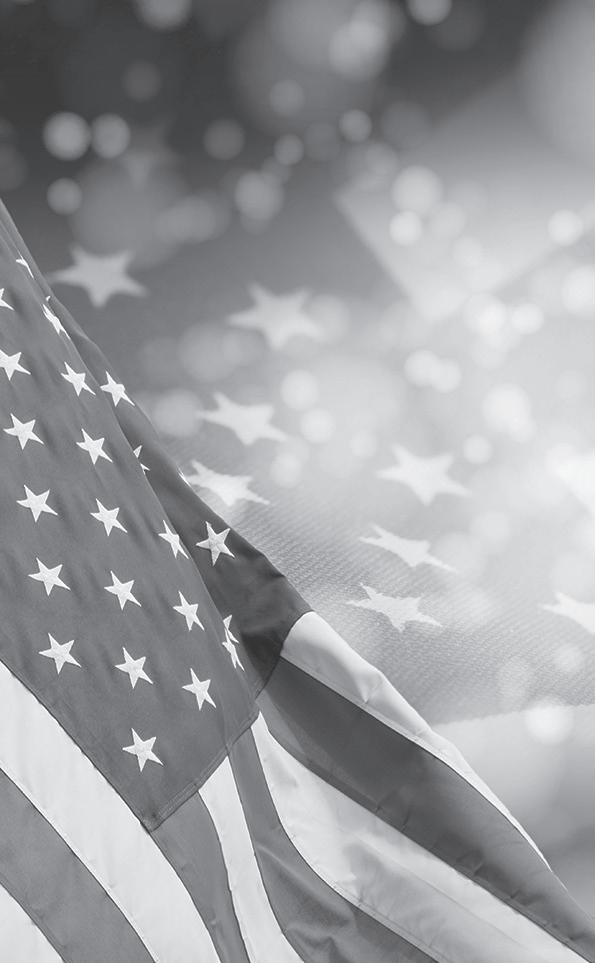


tening to the hurricane force winds overhead.
Hurricane Melissa was ravaging Jamaica when Borowsky shared his memories with The Era.
“I was looking at that this morning,” he said of the news coverage. “When you’re in the hurricane belt, you never know what you’re going to get yourself into. There’s no preparing for stuff like that.”
After their tent was knocked down in Louisiana 20 years ago, they righted the Porta-Johns and showers, cleaned up what was there and headed to their next parish.
“We had set up what were called points of distribution — a POD — food, water, diapers, clothing — in the first parish we went to,” he said. “We did quite a bit of work there.”
The second parish was St. Charles.
“We had set up in warehouses there,” he said. “We had set up points of distribution in an industrial park and then a parking lot in a grocery store that was no longer in use. The lot was basically open.”
As they distributed food, water and necessities to the residents, they shared conversations, met families and heard stories.
“It was completely unscripted,” Borowsky said. “You never knew what you were going to run into.”
They got to know some of the folks as they came back through in the weeks the Guardsmen were in Louisiana.
“The people down there loved us,”
Borowsky recalled. “They would recognize the Keystone on our uniforms and know we were from Pennsylvania.”
He spoke with affection, remembering the people the guardsmen helped. “There was never a dull moment.”
It was hot, he shared, being in Louisiana in the muggy end of summer, where the average temperature was in the high 90s.
“People had lost power,” he said. “We had an ice trailer from FEMA, an 18-wheeler.”
The ice helped keep food supplies from spoiling.
“We worked well with everyone,” Borowsky said. He shared a story of one native Guardsman who was a policeman, who took several of the Pennsylvania guys to see some of the sites of New Orleans.
“We actually got the tour on Bourbon Street,” he said. Far from the beads, beers and brouhaha of Mardi Gras, they got a different look at the city. However, even the cata-
strophic double whammy of Katrina and Rita didn’t kill the party spirit of the Big Easy.
“Some of these places even during the hurricane didn’t shut down,” he said. “Water got in but they were still serving drinks.”
The street signs were gone, and he witnessed the devastation at the Superdome, which had been opened as a refuge to about 30,000 people, but lack of power, sanitation and water

made conditions dire. A section of roof collapsed and the building sustained heavy damage. It took 13 months before the stadium reopened.
There are still parts of Louisiana that haven’t fully recovered after the hurricanes, and scars from the storms are still apparent.
Back home in Pennsylvania, though, Borowsky remains glad that he went, happy that he could help and pleased that he met so many people who were so very grateful for the help he could provide.
The activation was the largest mobilization of Pennsylvania National Guard troops since Hurricane Agnes in 1972. The initial lift occurred when some 120 soldiers deployed by Saturday, Sept. 3, including six water purification units.
One thousand soldiers left by ground convoy on Sept. 4, 2005, in almost 450 vehicles.
The remainder of the force, approximately 1,200 more soldiers, departed Sept. 5, by bus.
The soldiers eventually took responsi-
bility for managing the supply distribution system from FEMA and the Texas Bureau of Forestry. This mission required the soldiers to operate over a vast geographic area, spanning several hundred miles.
Leadership established two operations centers to better control the operation. The main tactical operations center was located on Belle Chasse Naval Air Station. A second command and control element took over the FEMA/Texas Bureau of Forestry incident command post and managed supply distribution operations in eastern Louisiana. In addition, they operated 18 points of distribution (PODs) throughout the state.
The Guardsmen who served on the mission were sworn in as peace officers to perform their duties in the state.
The state of Louisiana issued the state service medal for the Guardsmen, all of whom also received the Humanitarian Service medal from the Department of Defense.
By Deb Everts
LITTLE VALLEY —
A rare Army-Navy “E” Award flag, long-held by a prominent local family, has been donated to the Little Valley American Legion Post 531.
The generous gift was made by brothers Francis and Robert Simcick to honor local veterans and the memory of their mother, the late Judy Champlin Simcick.
In an official ceremony held Oct. 25 at the Legion, the Simcick brothers presented the pennant to Post Commander Allie Burdick. Other distinguished speakers included New York State Commander John Miga, Post Commander Allie Burdick, Brad Lockwood and post member Ron Ploetz. The Simcick brothers presented the flag to the legion on behalf of their family and their maternal grandfather, the late John Brown Francis (J.B.F.) Champlin.
An article published
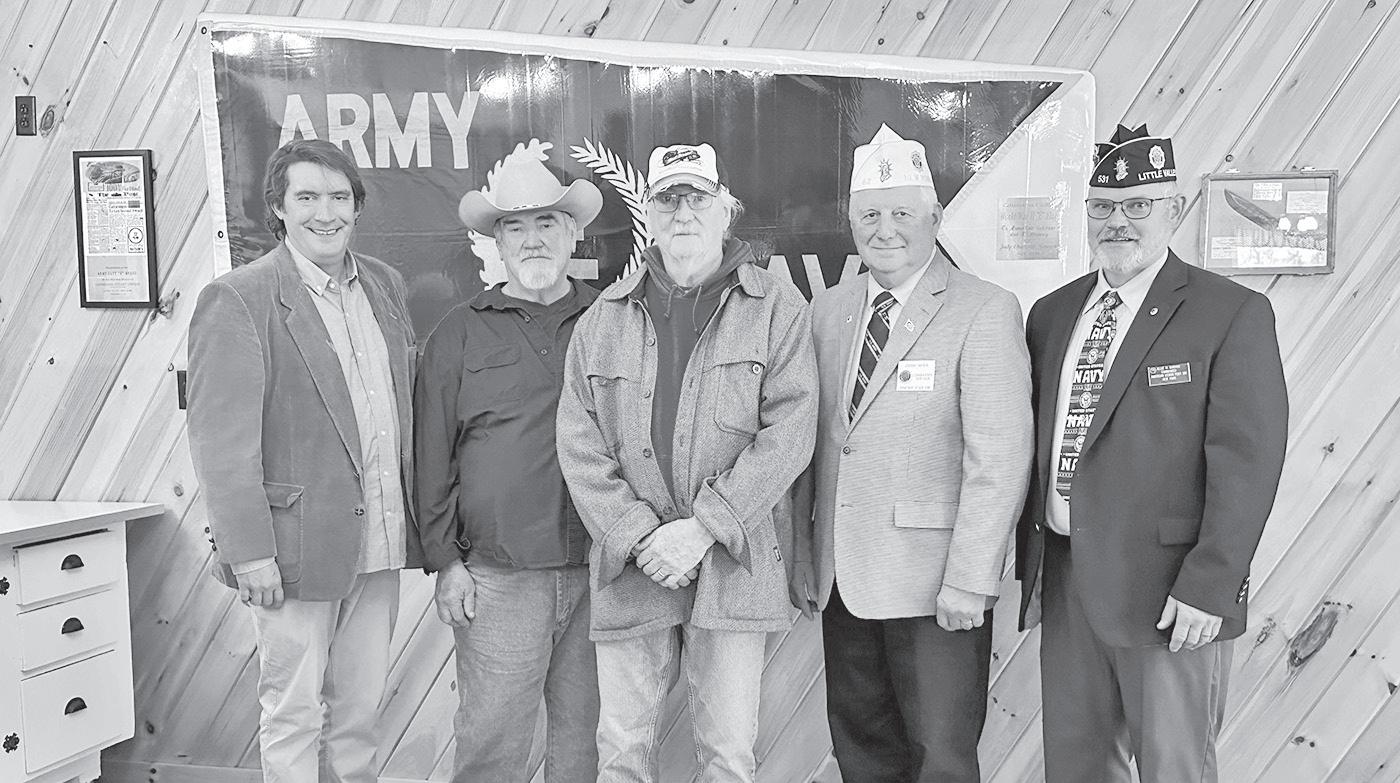
in Ellicottville newspaper The Post said the “E” flag was first presented to the men and women of the Cattaraugus Cutlery Company at the plant in Little Valley, Dec. 1, 1944, and again in 1945 as their millionth Commando knife for the armed forces rolled off the assembly line. J.B.F. Champlin, then president, accepted the award on behalf of the company both times,
with the second presentation featuring the addition of the “White Star” to their already won “E” flag.
The article also stated that executives and employees of the company received the coveted Army-Navy “E” flag award and emblems from high-ranking Army and Navy officers for far exceeding the production of folding machetes and

other combat knives for the armed forces.
Ploetz read a quote made by Champlin when the second award was given back in June 1945 — “Few, if any, small communities less than 1,500 population have had the privilege and distinction of having the Army-Navy present them with an ‘E’ award for their production of combat weapons during this war, to say nothing of thrice receiving that honor in six month’s time.”
He pointed out that Kinfolks, Inc., another cutlery in town, had recently received its “E” award as well.
“What J.B.F. said shows the significance of this flag to this town,” Ploetz said. “My dad was a knife maker at Cattaraugus Cutlery for 38 years — before and after World War II.”
State Commander Miga said not only was the “E” Flag unveiled, but they also honored the historic building,
built in 1909 and purchased by the legion in 1947.
“I’ve been traveling around New York state and have visited 34 counties in the last two months. This is very unique because you don’t see too many flags like this around,” he said.
THE ARMY-NAVY
“E” Awards program began in July 1942, as an honor presented to the top performers of the civilian war industry during World War II, according to The New York Historical. By the time the program ended in 1945, the “E” Award had been presented to 4,283 production facilities, representing only 5% of the estimated war plants in the nation.
Francis Simcick said he found the flag at his parents’ cottage at the Little Valley Rod and Gun Club and has had the pennant in his possession for a number of years.
“When I visited the cottage built by my grandfather, I opened a cedar chest and this flag was in there,” he said.
“My bet is mom kept this, or her brother Jack, when the cutlery closed.
I bet it’s been in that cedar chest since 1963, until I found it a couple of years ago. It was in a plastic bag with one of my dad’s WWII Navy uniforms.”
Thanks to the packaging and being stored safely in a cedar chest, the 80-year-old flag is preserved in pristine condition.
Lockwood, who was instrumental in finding
the flag an appropriate home, said he was incredibly happy when he saw an amazing picture of the “E” Flag on Facebook. He said Fran Simcick was flying the flag at the Little Valley Rod and Gun Club, and he was surprised that it still existed.
“I asked Brad (Lockwood) to find a forever home for the ‘E’ Flag, and he connected me with the Little Valley Legion,” he said. “It’s something that should be seen. The flag proves that our town and our family did something good.”
Simcick said that’s what Little Valley was about. He said the people who lived in town pretty much worked for a cutlery one way or another back in the late 1800s and throughout the early 1900s. The Cattaraugus Cutlery Company made it to 1963.
“My mom always told the story that after World War II, when they were rebuilding Japan, the steel the cutlery used for the knives was always good steel, but the Japanese could produce the same steel for about half the cost,” he said. “ They basically ran the Cattaraugus Cutlery out of business.”
The new home of the flag is befitting since American Legion Post 531 was once the home of Andrew Jackson Case and previously known as “Robins Roost.” The flag, approximately 8 feet long, will remain on display in the dining room of the legion for all to see.









By Sara Furlong
W.R. Case and Sons Cutlery and Zippo Manufacturing’s American roots run deep.
From stories of a lighter that saved a soldier’s life to Zippo’s wartime black crackle finish designed to reduce reflection, to Case’s M3 Fighting Knife and the V-42 Stiletto issued to the Devil’s Brigade — the first special service force.
After World War II, Case designed and produced into the 1960s its One-Armed Man’s Knife, a tool specially designed for amputees.
More subtle than these examples, yet equally important, is the support both Zippo and Case extend to its veteran and active-duty military employees.
Their endorsement was lauded Wednesday morning during a special ceremony held on the grounds of the Zippo/Case Museum and Flagship Store on Congress Street.
Mark Paup, Zippo and Case president and CEO, called the companies “two iconic brands that share more than 200 years of excellence in American manufacturing.”
Yet, he said, “Today’s award ceremony is a first in our historic companies’ history.”
There are federal laws in place, known as the Uniformed Services Employment and Reemployment Rights Act (USERRA) of 1994, that protect servicemembers returning to work after and during military duty.
Decades before US-
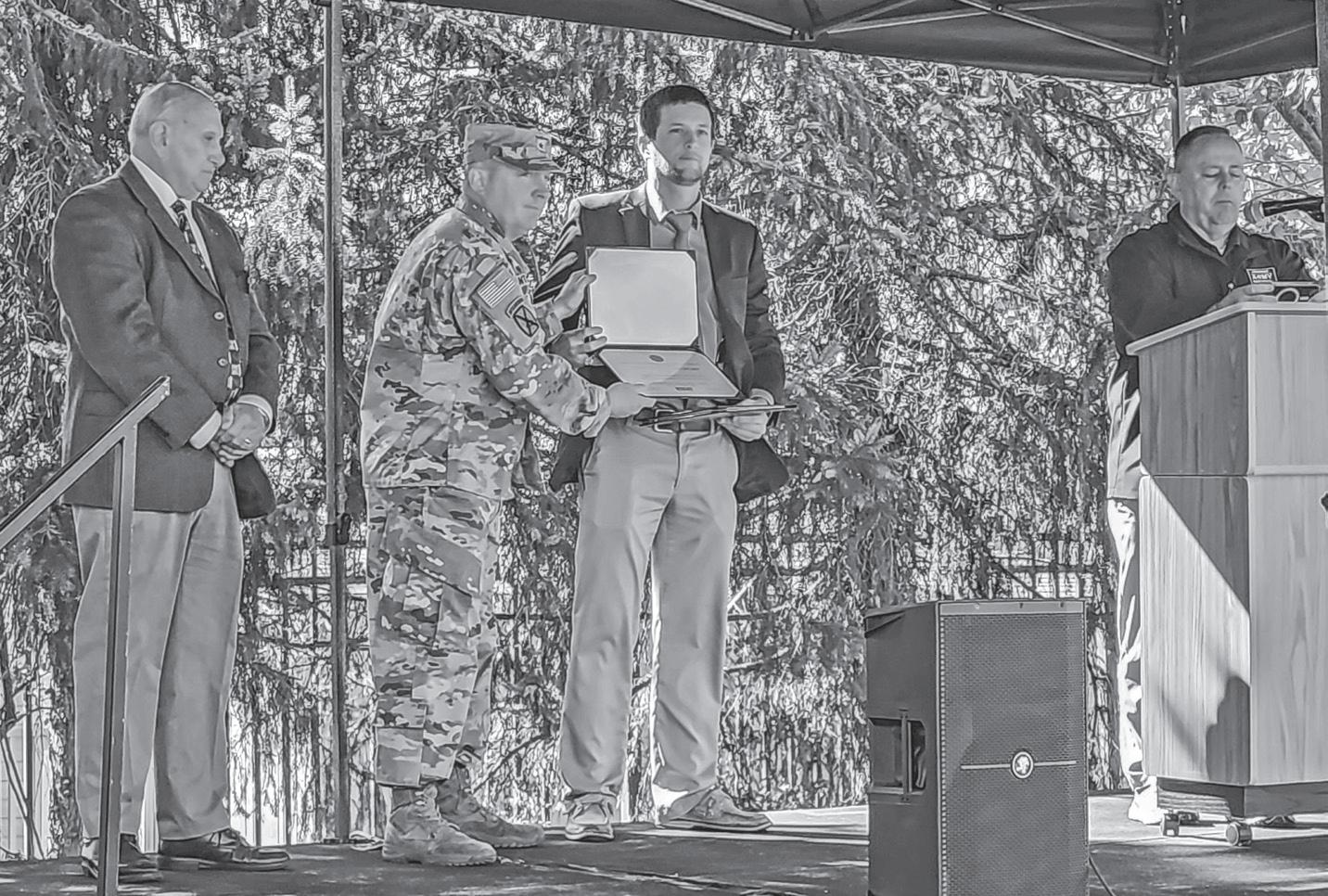
Brig. Gen. Francis R.
ERRA, the Department of Defense established the Employer Support of the Guard and Reserve (ESGR), which maintains a committee in every U.S. state and territory. In the early 1970s, as troops returned from an unpopular war in Vietnam and attempted to take up their civilian lives and work, some problems ensued. ESGR was formed to educate uniformed personnel and employers about their rights, mediate disputes and recognize supportive employers.
Erick Scott, specialist with the 1st Battalion, 112th Infantry Regiment, 56th Stryker Brigade Combat Team, is also a member of Zippo’s customer outreach team and nominated Zippo and Case for the Pennsylvania ESGR recognition. Scott described the companies’ contri-
bution of 13 boxes of basic supplies as his team “took direct fire twice from a violent, extremist organization” while they provided operational security and crisis response across outstations in the Horn of Africa in 2024.
“We did not have access to any stores and were relying solely on Amazon deliveries for even the most basic necessities,” Scott said. “Zippo’s generosity made a tangible difference in their daily lives, and that kind of heartfelt support truly deserved recognition.
Scott’s nomination stated, “Soldiers were prepared to face the incoming threat and were not nervous about how they were going to get by after. Four-star Gen. Michael Langley visited our base to congratulate us on our great achievement and I’m certain it was all due to
the soldiers being taken care of by companies like Zippo.”
He shared that when he returned from deployment in 2024, “processing a shift from a continuously hostile environment to the quiet comfort of home,” Zippo invited him to its veterans luncheon and surprised him with a collage of photos from his time away.
“That moment showed me, without a doubt, that the people and the company genuinely cared about me even when I was thousands of miles away, Scott said. “It’s something I’ll never forget.”
Brig. Gen. Francis R. Montgomery of the Pennsylvania Army National Guard said, “Employers are part of the process that makes this whole thing work. There are some companies out there that don’t (support employees who serve or have served).
“That’s not the case here, pun intended,” Montgomery said. “You guys do a great job. The fact you’re this involved and you take care of your veteran employees is very important to us at the Pennsylvania National Guard.”
Grant Duke, co-owner of Zippo and Case, said, “It’s my pleasure and honor to accept these awards on behalf of Zippo Manufacturing and W.R. Case and Sons.
ive and understanding employer makes all the difference in the world. It’s worth its weight in gold,” she said.
“They are constantly training. They’re at the ready for anything that happens in the world. Even if we’re not actively in a war at the moment, (Guard and Reserve) have to train to the same standards as their active-duty counterparts,” Golden continued, adding that “it’s mutually beneficial (for employers) to support the servicemember and to be understanding of the training needs.”
Scott encouraged other businesses to “go above and beyond, as Zippo has done.”
“Supporting veteran employees isn’t just the right thing to do,” Scott








Zippo and Case received the Above and Beyond Award, ESGR’s highest honor, “for outstanding service and continuing support to the national defense;” and the Seven Seals Award, recognizing their “meritorious leadership and initiative in support” for Guard and Reserve personnel across all branches.
Then, Zippo Director of Employee Relations Ed Hayden and Benefits and Human Resources Information System Assistant Renee Mika were each presented with a Patriot Award, for “contributing to national security and protecting liberty and freedoms by supporting employee participation in America’s National Guard and Reserve forces.”
“Without the bravery and selflessness within every one of your ranks, we wouldn’t have the country we love today,” he continued. “Businesses shouldn’t need recognition for supporting our servicemembers with employment opportunities. It should be viewed as a humble civil duty, like the sacrifices you all make serving our nation.”
said, “it’s an investment in people who bring unmatched dedication, resilience and leadership to the workplace.”
Golden described servicemembers’ lives as a three-legged stool. The soldiers themselves, who have to be fit and prepared, the families many soldiers support and their employers.































Scott said Hayden assisted him with the complexities of Guard scheduling and changes as well as checking in with his family while he was deployed. Mika, upon learning that Scott’s team was in need, “jumped to help and coordinated getting us 13 boxes of supplies to help the entire unit.”











































Debbie Golden, an ESGR representative in attendance at Wednesday’s ceremony, said the idea that Guard and Reserve soldiers give up just one weekend a month and two weeks a year is wildly outdated.
“If any one of the legs on that stool breaks, or is faulty, the stool cannot stand,” she reasoned. “When you have an employer that goes above and beyond it is really a wonderful, honorable thing and to be commended.”




“It’s a juggling act to balance family, a civilian job and your military obligations, and to have a support-
“A lot of people feel patriotic,” Golden said, “but it’s the patriot who takes action and makes a difference.”
























































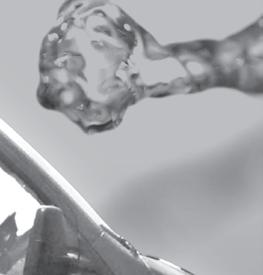





















Adrian Paul Murrin was a casualty of World War II and the only Cattaraugus County attorney killed during the war. He was known as “Ade,” born in Olean, the secodnd son of Robert and Cecilia Murrin. His siblings were Jack, Robert, a local attorney in the law firm
Murrin & DeRose, and Patricia Murrin Kehoe, whose husband was James Kehoe of the law firm Kehoe and DeRose. Mary Kehoe Fay, who lives in Olean, is his niece.
Ade Murrin attended Olean High School and was deemed “the most optimistic” and the “class dreamer” in the OHS Yearbook of 1932, of which he was associate editor. He was a graduate of St. Bonaventure University and Union College Law School. He joined his father’s firm, Murrin and Murrin, in 1938. Ade married Elsie Smith, from Allegany, in December 1941 and soon after enlisted in the service in Officer
Candidate School of the Air Corps. He later requested to transfer to the Army infantry (to be on the front lines) and was commissioned a second lieutenant. He headed a platoon that stormed Utah Beach on D-Day, June 6, 1944 — his transport ship was sunk but the soldiers swam to shore valiantly fighting the Germans.
The family never knew how he died until 15 years later — they received a phone call on Memorial Day from his intoxicated commander who admitted he was the one who gave orders for Adrian to advance and still felt guilty that Adrian was killed (on his 30th birthday, June 14). He survived
eight days fighting the Germans until he was charging an enemy position and was shot by a German who was hiding behind a hedgerow armed with a machine gun. His family received notice on July 7, 1944.
Fifty-five years later, a St. Bonaventure student found Adrian’s name on the military memorial at SBU, and contacted Adrian’s brother, Bob, and sister, Patricia, for an interview. Bob related, for the first time, that while he himself was serving in Texas, he suddenly awakened at 2:30 in the morning on June 14 and “knew something terrible had happened to Adrian — the same time Ade was killed.”
His future brotherin-law, James Kehoe, said of Adrian: “He had a wonderful sense of humor and the greatest laugh!” At the time he was killed, he and Elsie had a son, Thomas, who was 1 at the time his father was killed, while Elsie was three months pregnant with Charles, born in December 1944. Tom and his wife, Sandy, live in Penn Yann. Charles passed away in 2023 from medical complications due to exposure to Agent Orange in Vietnam.
As stated by his superiors, Adrian made the supreme sacrifice for his nation and his comrades, as had the fallen soldiers who fought beside him. He earned the Purple Heart for his sacrifice and was distinguished for his valiant military career. He is buried at St. Bonaventure Cemetery in Allegany. He was honored by the Cattaraugus County Bar Association on Dec. 3, 1945, being the only county attorney killed during World War II. Elsie passed away in 2006 and is buried with Adrian.
The Olean City Republican Committee honored Adrian’s ultimate sacrifice during their annual Lincoln Day Dinner in 2024 with a certificate of service given to Tom by Adrian’s niece, Mary Kehoe Fay of Olean.
By Marcie Schellhammer
ELDRED — As artwork goes, it’s stunning — a giant tapestry of a blond, blue-eyed hunter holding a spear, a falcon perched on his arm, a fox sneaking behind his feet and a stag immediately behind him. Oak leaves and acorns surround the hunter. For its age, likely
more than a century old, the tapestry is in wonderful condition.
As a piece of history, it’s chilling. Even a bit upsetting. It’s not so much the tapestry itself, but where it came from and what might have happened in its presence that could cause the unsettling feeling.
The hand-embroidered tapestry was commissioned by Nazi
Heinrich Himmler, the right-hand man to Adolf Hitler. The architect of the Holocaust, Himmler is known as one of the most evil men in history. The piece of art that once hung on the dining room wall of Himmler’s villa in Tegernsee, Bavaria, is on loan to the Eldred World War II Museum.
Himmler was the



head of the SS and chief of the German Police. He was the architect of the “Final Solution” and was in control of the concentration camp system.
Tegernsee
Himmler’s villa at Tegernsee was overtaken by Allied forces in May 1945. A young soldier, Christian Lisella from Summit Hill, was attached to the 636th Tank Destroyer Battalion, and part of the forces that liberated Tegernsee.
Lisella had joined the U.S. Army in the summer of 1942, and served with the battalion through 1945 throughout Africa and Europe and in the five major battles of World War II, including the Battle of the Bulge. Lisella helped in the liberation of Dachau in April 1945, and earned a Bronze Star.
When the soldiers entered the upscale villa of Himmler in Tegernsee, many took items that they could carry. Some experts speculate the looting was for the soldier to have a souvenir from their wartime travels, while others estimate it was in retribution for the crimes they had seen along the way.
No one’s quite sure why Lisella did what he did.
Museum Executive Director Liz Threehouse explained the young
soldier’s actions some 80 years ago.
“(The soldiers) went into the place and I found out from the family that there was a young lady there. They told her they weren’t going to hurt her. The guys were taking stuff from all over. (Lisella) saw this on the wall,” she said, gesturing to the tapestry on display in the museum. “He took it down, folded it up and stuck it in his stuff. This was May. In September he was home and discharged.
“He kept it rolled up. He never displayed it. He showed it to a few people. It got rolled up and stored.” It stayed in Lisella’s possession from when he removed it from the wall until his passing, and his family members — who appreciated its significance, but didn’t want to display it in their homes — loaned it to the museum. That helps track the authenticity of the piece, as does a tag on the back of the tapestry that has information leading to the piece’s designer, Professor Karl Diebitsch, and the assembler, his sister Elsie Siefert. On that patch is one of only two places where the SS is visible on the piece, the other is the front lower right corner.
“He designed many things for the Nazi SS. He was an artist,” Threehouse said of
Diebitsch, “everything from paintings to tapestries. He also designed the black Nazi SS uniform that was manufactured by Hugo Boss.” Symbolism
“It’s all very symbolic, the oak leaves are very symbolic of the Third Reich and strength,” Threehouse said. Referring to the hunter in the tapestry, she said, “He’s very Nordic looking. Himmler was friends with Professor Karl Dietrich. Himmler was into history himself. He thought he was a reincarnated knight from the Germanic Aryan age.”
History has it that Himmler felt he was a reincarnation of Henry the Fowler, a pre-Christian Saxon. He was said to be obsessed with Nordic “Aryan Race,” the master race that he believed created civilization.
“The tapestry speaks for itself,” Threehouse said. “It’s an Aryan looking guy.” Kyle Dunn, curator, agreed that while there are no obvious signs of the Third Reich on the tapestry, the hunter himself is certainly one.
“One big giveaway that it was a Nazi piece was the stark blonde hair, and blue eyes,” Dunn said. “It was the superior race that was going to take away the world’s problems. If



















































you want to be cool like these German ancestors who came before you, this is what you’re supposed to look like.”
Other symbols on the tapestry are more subtle — the oak leaves and acorns.
“They’re a symbol of high military distinction and military rank, similar to how we would put an eagle feather on a high-ranking military cap,” Dunn said of the leaves. “Oak leaves are used in a lot of military depictions. It’s a symbol of superiority, high rank, bravery, leadership. The German uniforms have oak leaves incorporated a lot.”
The acorn symbolizes endurance and resilience.
The tapestry is on display at the museum, not in the Holocaust room with some darker artifacts directly relating to the horrors of the camps, but in the open, with uniforms, helmets, mannequins and a parachute, along with the other items.
As a reporter spoke to Threehouse, several visitors stopped to see it, exclaiming their amazement that something so beautiful could come from such a dark time, and such evil. Threehouse said it’s important to history that items such as this are shown to the public.
“Sometimes people want to fictionalize everything that hap-
pened” in World War II. “This guy really lived, Himmler,” she said. “He had riches in places and power. We (American soldiers) came in and liberated and took this right out of his house.
“We get a visual, a dimension of history. It’s a part of history that can be taught. It’s just an authentic piece of history. It gives you a visual dimension to say these people existed. This gives you a little bit of insight into his leisure home on the lake and his child and wife.
“He had a lot of SS meetings at this place. It might give some insight into what went on in this guy’s mind,” she continued. “There’s a lot of ego in it. You
could take a deep dive into the psychology of the SS and the Third Reich. Something you put up on the wall in your dining room would be something you admire, you identify with — this is our history, this is who we are, we are mighty warriors. This is what this guy, who was a big architect of the Holocaust, identified with.”
Evocative Mixed emotions come with it. Dunn said, “We’re always happy to preserve items for the next generation to see. If you forget the past it will likely happen again. That’s one of our museum’s founding statements.”
To see something that was owned by Himmler makes things more real for people who might be generations or decades separated from the horrors perpetuated during that period.
“To see how persuasive the Nazi party was when it was rising up in the 1920s and 1930s, it was a period of mass indoctrination,” Dunn said. “It’s something we hope will never happen again. Around the world, holocausts are still happening.”
He spoke of nations where genocide still occurs — Darfur, Rwanda, Myanmar. “You need to stay vigilant.” One cannot tell from looking at a person, or at a picture of someone
like Himmler, of the evil that lurks inside. The same dichotomy comes when viewing the tapestry.
“It’s so ornate and professionally made,” Dunn said. “They definitely put a lot of work into that.
“Knowing who it belonged to and where it was, and the time period it existed in, it gives a whole other air to it.”
Really, that’s what a museum is about, the stories.
Dunn said, “Every artifact in our museum has a story attached to it. You can almost feel the history as you move through the museum. It’s an amazing experience to come through here.”
By Kathryn Ross
WELLSVILLE — In March a call went out for women veterans to join the first Buffalo-Niagara Honor Flight for women who served in the U.S. military.
Just as they did when they were in their teens, three Allegany County women answered the call.
They were set to leave Oct. 10 to spend a weekend in Washington, D.C., visiting historic sites dedicated to the nation’s founders and veterans with fellow women who served.
It was the first Buffalo-Niagara Honor Flight exclusively for women veterans. Although a few women veterans have participated in Honor Flights from Western New York before, they have been heavily outnumbered by men on the flights.
“This is the first all-women flight out of Buffalo,” said Kathie Timpano of Wellsville, who attended an orientation for the women’s flight recently.
Timpano as well as Barbara Gordon, also from Wellsville, were both on the Honor Flight, and joined by Kay Klein of Angelica. They each served in dif-

ferent eras and in different branches of the military — ranging from the Cold War 1950s to the 19-year-long United States involvement in the Vietnam War.
At 88, Gordon is the oldest of the trio. She served in the Air Force from 1955 to 1958, enlisting a day after her 18th birthday while living near Schenecta-

dy. After basic training at Lackland Air Force base in Texas, she was a cryptologist in the Pentagon, deciphering coded, high-security messages during the Cold War.
But she wanted to fly. As a girl traveling around the country with her parents and brothers, she was en-


amored of the women pilots during World War II, the WASPs (Women Airforce Service Pilots) who ferried planes, flew non-combat missions and sometimes towed targets the male pilots shot at. However, when she joined the AF, flying was not an option for women.
“What I remember most was that I was equal to the men I worked with,” she recalled. “I was paid the same and I was independent and free and living in Washington.”
Gordon was ranked as airman first class and worked in the sub-basement of the Pentagon,
and in the event of a nuclear attack (seemingly a real threat at the time) she said she was told to “bend over and kiss her tail feathers goodbye” because there was little chance of surviving or escaping from the sub-basement.
Today, Gordon, who teaches Getting Stronger Classes, credits her time in the military for her energy, good health and attitude. She believes all youth should serve a mandatory stint in the armed services to teach them discipline and commitment.










“We didn’t know what was going to happen to us,” she said.
Timpano enlisted in the Navy following her high school graduation because she knew her parents couldn’t afford to send her to college. She received medical training and served as a medical corpsman at St. Alban’s Naval Hospital
...continued on page 11
Timpano, nearly 80, she served in the Navy, although she can’t swim, from 1963 to 1966 as a medical corpsman, attaining the rate of hospital corpsman, third class. She recalled that she was in bootcamp in New Jersey when the country learned of the assassination of President John F. Kennedy.






















































Honor Flight continued from page 10
on Long Island, where she worked in nuclear medicine, female medicine and thoracic medicine.
After moving to Wellsville she worked at Kerton’s Florists. Today she does three shifts weekly at Hart House, teaches Growing Stronger Classes, is a certified lay server at her church and visits three nursing homes each weekend.
Of her military service, she says, “I loved every minute of it and my biggest regret is that I didn’t stay in touch with the women I served with.”
Klein is the youngest of the trio at 76. She served in the Air Force from 1968 to 1970 and was stationed at a hospital in the Philippines. There she was a surgical technician passing instruments to surgeons operating on soldiers wounded and injured in Vietnam.
“We had eight operating rooms and our patients arrived by plane loads,” Klein, who reached the rank of sergeant, recalled. “We worked
until there weren’t any more planes.”
Although she suffered from some sexual harassment while in the military, she said she enjoyed working with people from all over the country while she believed she was doing something important with her life.
Klein grew up in Oramel. She joined the military because her father had been in the military and because it offered her benefits and training and a college education — which she wouldn’t have attained otherwise. She earned a liberal arts degree from the University of Maryland.
Today she appreciates the structure serving in the military gave to her life. She moved back to the area to raise her children in a “smaller America.” She is a craftsperson and works in a store in Angelica. Her son and grandson followed her footsteps into the military.
As part of the Honor Flight the veterans was to visit Arlington National Cem-
etery, the Vietnam Memorial, the Tomb of the Unknown Soldier, the Iwo Jima monument, the World War II Museum and the Women’s Memorial Museum, among other monuments in Washington. They will also be guests at a banquet in their honor.
The entire trip was paid for through donations from Barbara and Patrick O’Connor, West Herr, the Gorden brothers and the American Veterans of New York, who provided $121,000 for the trip.
At orientation in Buffalo, the veterans saw a video message from author Kristin Hannah, who wrote “The Women,” a story of the difficulty women veterans, from World War I to as recently as the 1990s, faced in receiving recognition for their service and sacrifice.
According to the Women’s Memorial, since the Revolutionary War, more than three million women have served in or with the armed forces of the U.S. — every one of them volunteers.
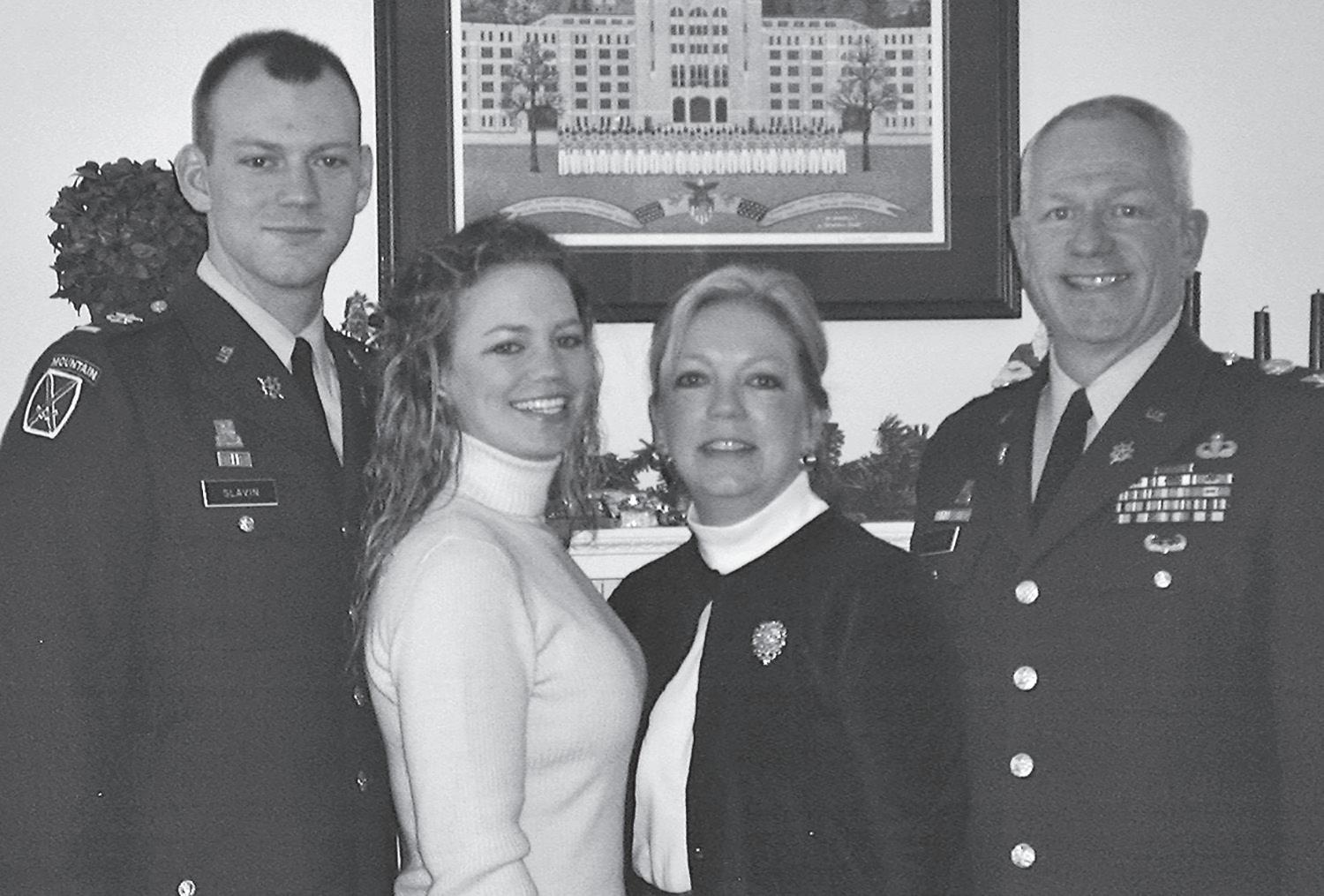
Retired U.S. Army Col. Jim Slavin (right), a 1971 graduate of Otto-Eldred High School and a 1975 graduate of the U.S. Military Academy at West Point, N.Y., is shown with his son, Christopher (left), who graduated from New Mexico Military Institute and was comissioned as a second lieutenant into the Army in 1999, along with Jim Slavin’s wife, Gail, and daughter, Alyson. The elder Slavin, now of Pinehurst, N.C., served until 2005 with deployments to Panama, Iraq, East Timor and the Balkans. He noted that two West Point classmates were Jack Craven from Bradford High School and John Sidoni of Elk County Christian High School in St. Marys. Christopher Slavin served combat deployments in Iraq and Afghanistan.
Sometimes, being a woman of a certain age — someone who could not be drafted for the Vietnam War — has made me view Veterans Day too casually, as merely a day off. But over time, and with perspective, I’ve come to see it differently.
Recently, I came across a photograph of my grandmother and her boyfriend. He had served in World War I and often told stories of his service — particularly how he had once hoped to join a motorcycle unit in France, until he learned that most of those soldiers never returned.
My father enlisted in the Navy during World War II and served aboard an aircraft carrier. He shared vivid, and sometimes frightening, accounts of what he witnessed during his time at sea.
When the Vietnam veterans returned home while I was in college, they were met not with parades but with protests — a reaction that, in hindsight, I deeply regret. Since then, other troops have come home from deployments in distant places — yet few have been greeted with public celebration or
lasting recognition. Our troops helped save Europe twice. The world we know today might look very different had Hitler prevailed — those dystopian imaginings remind us of what was at stake. Since the end of the Vietnam War, American service members have been called upon time and again — often for defense, stability, and humanitarian purposes.
They have saved lives, defended fragile democracies, and provided relief in the wake of disaster — airlifting food to the starving, rescuing earthquake survivors, and rebuilding communities shattered by war and storm alike.
On Veterans Day, we owe them not only gratitude but understanding: a recognition that their sacrifices — often made quietly and far from home — have shaped the freedoms and stability we too often take for granted. And as we honor them, let us also pray that peace prevails for all who have suffered in the Israel–Hamas war and in every place where conflict endures.
Patricia Maiden, Wellsville
‘The last full measure of devotion’
Hero is a word often misused. It should have the narrowest of definitions. Simply, a hero/ heroine is someone who willingly puts his/ her life at peril for the sake of another. While on the NATO staff in 1960, I had the honor of serving with Col. Keith Ware. During World War II, then-Lt. Col. Ware was awarded the Congressional Medal of Honor for bravery above and beyond the call of duty. In 1951, when ordered to serve on the frozen grounds of Korea, Col. Ware, again, answered the call to duty.
By any standard, he had given enough for this country. Yet, when directed in 1967 to assume a senior position in Vietnam, Gen. Ware followed orders. You see, he believed in duty, honor and country
and in the integrity of senior military and political leadership; but, much of that leadership was corrosive, callous and deceptive as they sent thousands to a jungle already soaked with American and Vietnamese blood.
Not long ago on a trip to Washington, D.C., I saw Col. Keith Ware’s name. Tragically, it was etched on a stark, black wall surrounded by 58,000 other American names.
On Sept. 13, 1968, Maj. Gen. Keith Ware was killed in action in Vietnam. Embodying the words of a truly great president, Abraham Lincoln, Gen. Keith Ware “gave the last full measure of devotion” for this country.
Sam Sylvester, Bradford Vietnam 1969


Veterans Day is a time when we pause to honor the brave men and women who have honorable served their nation and its Constitution.
Today only 6% of the U.S. population are veterans, those who committed to sacrificing for their country. I am a veteran of the U.S. Air Force having served five years during the Vietnam War.
Unfortunately, the Trump administration, through its Big Beautiful Bill, DOGE and other policies demonstrate a disrespect for this service.
There are proposed cuts of 83,000 Department of Veterans Affairs employees leading to severe shortages of nurses, psychologists and other crucial medical support staff, longer wait times, unprocessed medical claims and reduced quality of care for mental health and suicide prevention services.
Veterans, who constitute 30% of the federal workforce, have been hard hit by government-wide staffing reductions.
Funding for crucial research and clinical trials including cancer research and programs for combat-induced PTSD have been
slashed. The budget for the National Institute of Health has been slashed by $18 billion, severely impacting research on cancer, Alzheimer’s and many other medical issues
Medicaid and SNAP benefits have also been negatively impacted. An estimated 1.2 million veterans are in households that receive SNAP benefits; in New York state the number is 56,000 veterans Automated review of disability filings has raised concerns from veteran’s organizations that such a process may not fully grasp the complexities of service-connected medical conditions.
The elimination of Diversity, Equity and Inclusion programs across federal agencies hobbles efforts to address historical racial inequities in veterans’ access to care and benefits. Approximately 28% of veterans are racial minorities.
It takes courage, sacrifice and commitment to serve in our country’s military and our veterans deserve better than what is being carried out and proposed by the Trump administration.
Rob Mrowka, Machias

















By Cory Angell
Oise-Aisne American Cemetery in France is the resting place for 6,013 Americans killed in World War I, including seven from McKean County. Christophe Clement, a local Frenchman, does his very best to honor them all.
“Christophe has devoted countless hours to remembering the young Americans who died near his home during both World Wars,” said Charlie Diaz, Oise-Aisne American Cemetery superintendent. “He has flowered graves at several of the 12 American cemeteries in France, documented personal histories, organized memorial events and welcomed families from across the Atlantic who lost their family members during those wars.”
Marking the 80th anniversary of victory in Europe, Clement led a memorial event for the Mayor of Gathamo, France. The community dedicated a monument to nine 28th Infantry Division soldiers killed there. It started because a family member called Clement looking for information on their soldier.
“What he does is extraordinary,” said Diaz. “He has shown us that remembrance is not just

about the past — it’s about gratitude from the French people that endures to this day.”
Diaz added that Clement used to ride on his bike when he was a teenager from cemetery to cemetery making sure the American graves were looked after.
“Christophe Clement has been a true friend of the American soldiers who gave all in defense of freedom,” said Dr. Walter Zapotoczny, professor of history and president of the 28th Infantry Division Association. “The 28th Infantry Division is deeply grateful for his willingness to look after the graves of our soldiers.”
“I take pride in what I do,” said Clement. “I want American families to know; a Frenchman looks after their soldier.”
This Veterans Day local soldiers that will
be looked after by Clement include:
• Private John G. Killen, Co. B, 162nd Infantry Regiment, 41st Infantry Division, Hometown: Rew, Died of illness on Nov. 9, 1918
• Private 1st Class Eldridge G. King, Co. A, 126th Infantry Regiment, 32nd

Infantry Division, Hometown: Port Allegany, Killed in action on 1 Aug. 1, 1918, Age: 20
• Private Arthur Joseph Marks, 168th Infantry Regiment, 42nd Infantry Division, Hometown: Kasson, killed in action July 30, 1918, Age: 25
• Mechanic Claud Neeley, Co. E, 112th Infantry Regiment, 28th Infantry Division, killed in action Aug. 9, 1918, Hometown: Kane
• Corporal Frederick W. O’Donnell, 16th Infantry Regiment, 1st Infantry Division (The Big Red One), Hometown: Bradford, killed in action July 21, 1918
• Private Edgar C. Wainright, Co. E, 112th Infantry Regt., 28th Infantry Division, Hometown: Kane, killed in action Aug. 9, 1918, Age: 23
• Private Stephen Rudolph Sankner, Machine Gun Co., 112th Regt., 28th Infantry Division, Hometown: Lewis Run, died of wounds Sept. 7, 1918, Age: 25 Serving with the 112th Machine Gun Co., Sankner’s final hours

are unknown. However, a casualty report that coincides with his death in the history of the 28th Division in the World War provides some insight.

On Sept. 6, 1918, the 112th Infantry soldiers had been relieved from the heavy fighting in the Battle of Fismes and rested near the town of Dravegny. An aerial raid was conducted by the enemy on the troops of the 112th. The German planes dropped 15 projectiles, causing six killed and eight wounded in the Machine Gun Company as well as one in Company K. It is likely that Sankner suffered injuries that day and would die of his wounds the next, later being buried in the Oise-Aisne American Cemetery, never to return home.
The 28th Infantry History in the World
War does show that the 112th was heavily engaged on Aug. 9 crossing the Vasel River in the battle for Fismes. Company E is not mentioned specifically but the fighting involved three enemy counterattacks on the 112th’s right flank. The regiment was successful with a platoon of “one pounders” against German machine gun positions (35 mm British-made auto cannons). German sniper fire was heavy. The 112th was able to effectively counter with their own snipers, but the fighting was heavy for Fismes the day Wainright and Neeley were killed.
John L. Karl of Allegany enlisted in the U.S. Army in June 1970 and went through basic training at Fort Jackson, S.C. Afterwards, he was deployed to Vietnam in December 1970 and was assigned to the 5th Infantry Division, 1st Brigade at Quang Tri.
“Our area of operation was along the Demilitarized Zone and the Loation border,” Karl said. “My duties in
the 3rd Platoon of Bravo 1/11 were to assist and support the machine gunner by carrying additional ammunition and to provide backup in the event he was unabdle to perform.”
At the end of January 1971, Karl’s battalion took part in Operation Lam Son 719, supporting the South Vietnamese Army’s invasion of Laos.
“There were 107 confirmed helicopters shot
down during this 2 1/2 month campaign,” Karl said. “In my brigade alone, 58 soldiers were killed and 431 were wounded. There was a total of 253 Americans killed and 1,149 wounded in this entire operation.”
The purpose of the operation was to cut off the use of the Ho Chi Minh Trail, which was to prevent the resupplying of the North Vietnamese Army forces’
spring offensive against South Vietnam.
“My platoon did cross over into Laos fdor a short time and sustained significant casualties as a result,” Karl said.
Later in his tour he was transferred to to the 1st Air Cavalry at Bien Hoa, Vietnam, for his last 2 1/2 months in country. In January 1972, he was honorably discharged from Fort Carson, Colo.

December 17, 1925 - October 8, 2020
ians in Holland.
Joseph Leo grew up in Oneida, New York and was eighteen when he joined the Army Air Corps during WWII. In 1944, he was sent to Fort Dix in New Jersey for induction. His aptitude test showed he was a good typist, and they were going to keep him at Fort Dix during the war.
“I said, ‘Sir, what am I going to tell my grandchildren? I fought the war in Fort Dix?’ Wrong thing to say. The officer looked at me and I can still feel his eyes boring right through me. He said, ‘Soldier, you’re in this army to do what you’re told.’ ‘Yes, sir,’ I said, ‘but I’d prefer to fly.’”
A few nights later, Leo was marched to the train station. “We were almost to Texas before I knew where we were going—the Air Force. I think that officer did it. He saw my enthusiasm. And I ended up in the Air Force,” remembered Leo.

Leo was then sent to Las Vegas, Nevada for gunnery school, and then to Florida where he was assigned to a 10-man crew. In Savannah, Georgia, the crew picked up a brand new B-17 and headed overseas. They were stationed in Eye, England. Leo was a B-17 waist gunner with the 490th Bomb Group. He recalled a hazardous bomb run in overcast weather. On that mission they were flying what they called, “tailend Charlie”. When
extra planes were available, they would send another plane up which flew nearly outside the formation.
“One of the other planes aborted the mission. He had to go back, engine problem or something. We took his place but we had to get all the way across the formation. So we worked our way through the planes … the overcast got higher and higher and the planes got more buried in the fog. Two planes collided in front of us.
Of course it happened so fast that I didn’t see it. I was looking out the side window. Our pilot pulled the plane up, and he could have hit another plane himself. Our navigator set a course south, hoping to get down into France so that we could land there. We came out over Frankfurt, Germany and the sun was shining. They didn’t shoot at us. That meant that they probably were going to send some fighters up to get us. But they didn’t, and I don’t know why because we were dead ducks all by ourselves over Frankfurt. So, we got over into France and found a field, but we didn’t have to land. They sent us back to England. They already had us reported as one of the planes that collided.”
Towards the end of the war, the Americans made a truce with Germany in which they were allowed to drop food to starving civil-
“They would let us do it but they couldn’t guarantee us that all the troops had got the message, because communications were very bad with the Germans,” said Leo. “We had to fly with our bomb bay doors open and wheels down. We were told to fly between 50 and 100
feet, and not to hold a formation. We filled our bomb bay with food and dropped it behind the lines.” Leo flew a total of 15 missions during WWII. He later moved to Portville, New York, where he and his wife, Betty, raised their two children.












































































Philip L. Smith of Eldred, Pa., was drafted into the U.S. Army and after basic training in Virginia he was sent to Korea.
With his experience working for the Pennsylvania Railroad, he was assigned to a hospital train. His job was to keep the train in running condition. The train picked up wounded soldiers from the front line during the Korean War (1950-53) and brought them south to the port city of Inchon, where the soldiers could be sent out to hospital ships off the coast.
Smith related to family that it was often difficult to see the wounded U.S. soldiers and Marines, many of them amputees or with serious wounds.
“I started talking to them to cheer them up, and then they started talking to each other,” he recalled. “One young man looked at my boots and told me to take his new ones. He only had one leg and said he didn’t need them.
“They all started laughing and joking. They thanked me for my interest ... and I was glad for my actions.”







Eric Lundberg of Portville, N.Y. enlisted in the United States Navy in December of 1950. On December 26, the day after enlisting, he reported to Buffalo before being sent for training in Newport, Rhode Island. After boot camp, Eric attended a Naval school in Great Lakes, Illinois. Following graduation,

the sailors who received the highest marks had the first choice of shore stations and ships. Lundberg was in the middle and when it came to his turn, all the shore stations were gone.
“I thought, ‘Well, what’ll I choose? If I’m going to be in the Navy, maybe I better find a ship that’s going to different places and see the world.’
That’s why I chose the aircraft carrier U.S.S. Franklin D.Roosevelt CVB42,” recalls Lundberg.
After three cruises to Europe, the ship was going to be decommissioned in the state of Washington, and Eric was given the opportu-
nity to travel around the horn of South America. They sailed to Brazil, Uruguay, Argentina, Peru, San Francisco, and finally anchored in Seattle where he received his next orders—Japan. “What in the world are they sending me to Japan for? I’ve only got six months left! They’re going to put me on a boat and send me to Japan just in time for me to turn around and come home,” he thought.
Lundberg soon found out he was being flown to Japan and replacing another sailor who was getting out of the service. When Lundberg arrived, he was given the ship USS Erben DD631. During the day, they were anchored out at sea. At night, they patrolled Korea. Lundberg was in Japan for two weeks before the Navy brought the ship back to Long Beach, California where his wife, Betty, was waiting for him.



































































































































Hinsdale native Erik D. Mason, now of Allegany, put his computer science background to work in defense of the nation.
A 2002 graduate of Kutztown State University of Pennsylvania with a degree in computer science, he also earned a master’s degree in 2016 from Syracuse University in telecommunication and network management.
In 2002, he enlisted in the U.S. Army and accrued three years of active duty service before gaining acceptance to Officer Candidate




School — earning a commission in December 2005.
He served a total of 14 of active duty with a total of 3 1/2 years deployed to multiple countries in the Middle East — Iraq, Kuwait, United Arab Emirates and Afghanistan. Rising to the rank of major, he also accrued nearly a year of service in the Army Reserve.
The majority of his postings were in communications and IT roles, from the 1st Armored Division as a team chief to platoon leader in the 54th Signal
Battalion in Kuwait and roles with the 5-52 Air Defense Battalion out of Fort Bliss in Texas. He also served for two years in the 10th Mountain Division out of Fort Drum and he was an IT projects officer with the U.S. Southern Command with a posting in Miami. In addition to OCS, Mason is a graduate of the Signal Captain Career Course, Information Systems Management Course and Signal Basic Officer Leadership Course. His awards include Presidential Unit Cita-
tion, Meritorious Unit Citation, two Meritorious Service Medals, six Army Commendation Medals, Army Achievement Medal, Good Conduct Medal, National Defense Service Ribbon, Afghanistan Service Medal, Global War on Terror Expeditionary Medal, Global War on Terrorism Service Medal, NCO Professional Development Ribbon, Army Service Ribbon, four Overseas Ribbons and a NATO Medal. He and his wife Aimee have a 9-year-old son, Trevor.



















































































































































































































































































